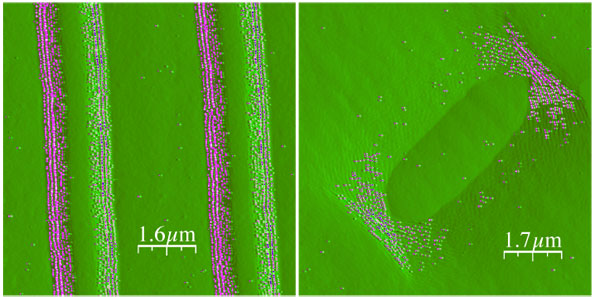| Posted: Apr 12, 2006 | |
Quantum dot necklaces and other QD chains |
|
| (Nanowerk News) For the past two years, the molecular-beam-epitaxy (MBE) group at the University of Arkansas has developed a novel growth procedure to laterally line up self-assembled InGaAs quantum dots (QDs). The group's ability to control the size, composition and position of the QDs during the growth process opens the possibility of engineering some interesting electronics and optoelectronics device structures. In a new report they demonstrate a unique approach that uses QDs as its building elements. The experimental results suggest that this approach has the potential to be used to fabricate single QD chains or necklaces or almost any pattern. | |
| Generally, the capability to spatially localize the self-assembled QDs will benefit all the QD-based electronic and optical devices, including QD lasers and detectors. Especially for QD-based optical memory devices, one needs to have precise control of the QD position for information addressing. Another possible application would be in Gain Coupled Distributed Feedback QD Lasers, where it is needed to encourage the formation of InGaAs QDs into designed areas. | |
| Professors Gregory Salamo and Zhiming Wang, who lead the MBE group, together with first author Jihoon Lee and co-authors Baolai Liang, William Black, Vasyl Kunets, and Yuriy Mazur report their most recent finding on QD chains in an article titled "Selective growth of InGaAs/GaAs quantum dot chains on pre-patterned GaAs(100)" published on April 7, 2006 in the online edition of Nanotechnology. | |
| InGaAs is a semiconductor composed of indium, gallium and arsenic. It is used in high-power and high-frequency electronics because of its superior electron velocity with respect to the more common semiconductors such as silicon. InGaAs quantum dots have been studied extensively for their potential for electronic and optical devices. | |
| However, this potential relies on the ability to achieve high spatial organization as well as high size homogeneity during the QD structure fabrication process. This has been a considerable challenge so far. The Arkansas researchers now demonstrated that the use of shallow-patterned substrates (modulation depth of only 35 nm), coupled with the growth of multiple layers, leads to the selective formation of InGaAs QD chains. | |
| Wang explains to Nanowerk: "By vertically stacking multiple layers of InGaAs on pre-patterned GaAs(100) substrates, we demonstrate the selective formation of quantum dot chains in desired spatial regions." | |
| In fact, the experimental results in this article demonstrate other interesting QD arrays as well. | |
 | |
| Atomic Force Microscopy (AFM) images of QD arrays formed through stacking multiple InGaAs layers on pre-patterned GaAs(100) surfaces. Left: on line pattern along [01-1]; Right: on downward square pattern. (Source: MBE group, University of Arkansas) | |
| "One of the more exciting possibilities for QDs is to use them as building blocks to fabricate organized arrays in any pattern" says Salamo. "In this way, one can design a structure with unique properties much like an organized array or lattice of atoms has a behavior uniquely different from the individual atom." | |
| Salamo concludes: "The new technique can be used to fabricate QD chains, necklaces, or three dimensional lattices, and as a result, engineer the optical or electrical behavior of the array." | |
| Salamo and Wang published numerous papers on their work in Applied Physics Letters, Journal of Applied Physics, Physics Review Letters and others (a full list can be found on Wang's homepage). | |
| Several international research groups are working with the Arkansas group on nanoscale characterization of these QD structures, such as: the University of Oklahoma (USA), Humboldt University (Germany), the University of Alberta (Canada), and the Institute of Semiconductor Physics (Ukraine). | |
 By
Michael
Berger
– Michael is author of three books by the Royal Society of Chemistry:
Nano-Society: Pushing the Boundaries of Technology,
Nanotechnology: The Future is Tiny, and
Nanoengineering: The Skills and Tools Making Technology Invisible
Copyright ©
Nanowerk LLC
By
Michael
Berger
– Michael is author of three books by the Royal Society of Chemistry:
Nano-Society: Pushing the Boundaries of Technology,
Nanotechnology: The Future is Tiny, and
Nanoengineering: The Skills and Tools Making Technology Invisible
Copyright ©
Nanowerk LLC
|
Become a Spotlight guest author! Join our large and growing group of guest contributors. Have you just published a scientific paper or have other exciting developments to share with the nanotechnology community? Here is how to publish on nanowerk.com.
